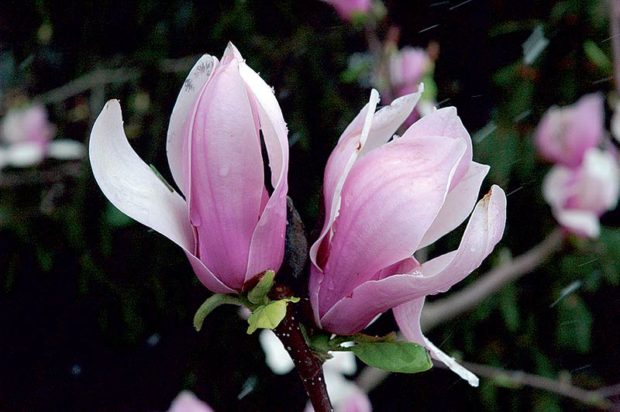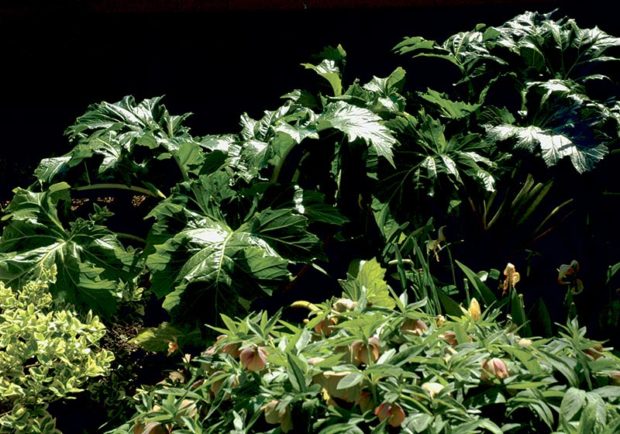How to help your plants make it through the frosty weeks of April
by Janet Macunovich
Photographs by Steven Nikkila
Plants are most susceptible to cold after they begin to wake up in spring. Buds, bark and roots that were hardened to the point of being able to weather minus 20 degrees in January become irreversibly soft by late March or early April. Then they may be seriously damaged at 25 degrees and killed outright at 10 degrees. Sudden, large drops in temperature hurt them most, and that’s what April frosts usually are—frigid packets of air that drop from clear skies after a balmy, slightly breezy day goes still at sunset.


Consequences of spring freezes may take days or even weeks to develop and are often lumped in with “winter kill.” We may even fail to recognize them as cold damage because they appear long after we’ve forgotten the frost. Then we see leaf drop, bud blast, aborted flowers, splitting bark, scorched foliage, freeze-dried twigs, stunted growth, susceptibility to disease, and failure to flower or flourish.
We often spend hours in late fall putting special plants to bed with wilt-stop coatings, burlap screens, elaborate mulch blankets and one last watering before the ground freezes. Those measures may have made a difference—that marginally hardy rosemary may have survived in its protected alcove and the rhododendrons and boxwoods stayed moist enough to bring their leaves into April unscathed. Yet what’s alive right now may be relegated to the compost pile and labeled “not hardy” if we let down our guard during this last leg of the journey.
Here are ideas to help your plants pass without harm through these next few, most risky weeks.


Moist soil makes a warm night.
You can fight frost with water, but you’ll have to aim the hose at the plants’ roots, not up at the leaves and stems.
An inclination to sprinkle at-risk foliage is understandable if you have seen nursery stock or an orchard protected from spring frost in rather dramatic fashion, by sprinklers that run all night to coat the plants with ice and all morning to ease the ice’s passage. However, this technique is one that warrants a “don’t try this at home” caption. That’s because it’s the creation of ice, not its simple presence, that works the magic. Plants benefit from the heat given off by each new drop of water as it enters an icy state. Standard oscillating and rotating sprinklers can’t deliver the amount of water or relentless coverage needed to foster continual ice formation.
What you can do with water is to stoke the radiator below each plant. Keep an eye on the three-day forecast so you can tend your plants the day before a frost is due. Soak the soil—avoid splashing the branches and foliage. Moist soil absorbs more heat from the air by day and radiates it longer and more steadily into the night than dry soil. That’s one reason that frost is always more likely over sandy ground than clay.
Don’t over-do. If your garden is very well-drained, you may be able to water with abandon but if there’s any chance the soil will become waterlogged, quit. Soggy roots are more trouble to a plant than frosted tips.
Everything’s warmer under a tent.
Everyone knows that heat rises but many are surprised to know just how much warmth can radiate from the soil. Soil temperature in the Midwest in late winter and early spring may be in the 20s or perhaps 30 degrees from ground level to two feet deep. Below that the ground remains at about 50 degrees. If the soil is loose and airy, that heat rises steadily through and out of the soil. It can preserve plants and plant parts close to the ground during a frost.
Cover a plant with something that seals its connection with this radiator. Within that tent the air may be 5 degrees warmer than in the open.
Fiber makes a great frost blanket.
Don’t use plastic to cover plants, or if you do, place props to hold it well up off the leaves and twigs so it can trap ground-warmed air around all parts of the plant. Since plastic is such a poor insulator, any bit of plant touching the plastic is essentially in contact with the frosty air and likely to freeze as if unprotected.
The better choice for frost protection is cloth, replete with tiny air pockets. You can use old linens and blankets if they’re light enough to cover without crushing delicate foliage. To use heavier materials, first place props to bear the weight.
Lightweight fabrics developed specifically for plant protection are called floating row cover, frost blanket, frost cloth, plant cover, and spun-bond polypropylene—all with various brand names. These products are light enough in most cases to be supported by the plant itself and come in sections or rolls wide enough to cover a shrub or a whole bed of flowers or vegetables. Permeable to light and water, they can be left in place even on cold days without smothering the plant they’re protecting. They are made in a range of weights from about one-half to several ounces per square yard. In general, the heavier the cloth the more light it blocks, but the more heat it can hold—the lightest promise just 2 or 3 degrees of frost protection while the heaviest claim eight.


It’s a cloche call.
The traditional cloche is simply a large glass jar that can be inverted over a plant. More recently, sections of glass or plastic clipped together to make tents over individual plants or rows have been included under this term.
Plastic tunnels covering rows of plants are sometimes called cloches, too. They’re made by bending heavy wire into big U shapes, sticking them upside down into the ground, and then covering them with plastic from a roll. Glass is better than plastic in terms of the light, warmth and humidity it affords a plant, but shatterproof plastic is safer for garden use. Plastic cloches can provide protection from hail as well as frost.
Plastic milk jugs and soft drink bottles can be pressed into service as cloches. Cut off the bottom of the jug or bottle and press it firmly into place as you cover the plant so its cut edges sit securely in the soil. If days are warm, remove the bottle cap to vent excess heat.
A modern twist on the traditional cloche are season extenders like the Wall O’ Water. A plant is encircled by this cylinder of compartmented plastic—basically a double sheet of heavy plastic seamed to form pockets that can be filled with water. The water absorbs radiant energy by day and at night releases it to the plant in its embrace.

Gracious sakes, come in outta that wind.
Our mothers, grandmas and aunties were right—one can catch one’s death in a wind. Cold that wouldn’t otherwise harm a plant can kill if drying winds accompany it. Wind is even more damaging to plants during early spring cold spells than it is during the depths of winter. So keep that burlap screen or snow fencing in its place several feet to the windward side of your broadleaf evergreens.
One reason spring wind is so devastating is that air temperatures during the day are warm enough that a holly, rhododendron, boxwood, pieris or grapeholly leaf can sustain photosynthesis. Those leaves lose water through their pores during that process. Yet a cold snap can freeze the top inch of soil where these plants have many fine roots. The next day, the plant sits in the sun losing water through its leaves but the water the roots need to replace it is locked in ice. When water runs short, the losers are the aerial parts furthest out—tips and emerging buds—as well as leaf edges that have “softened” as they quit the devices that added up to seasonal hardiness. We often don’t see the damage until May, but the scorched tips and leaf margins we see at that time began in that April freeze.
If you wonder whether you should protect plants from wind, look around your neighborhood for trees that stand alone, away from the protection of a grove or any buildings. Are those trees symmetrical or distorted? Distortion on one side can indicate severity and direction of the prevailing winds that dry and kill in late spring.
Cover those feet.
Mulch is a another strategy that’s important to understory species with shallow roots, such as rhododendron, holly, Japanese maple and magnolia. A study in Wisconsin put a number on the value of mulch. That is, when air temperature falls to 1 degree, the soil there drops to 16 degrees if it has a three-inch mulch blanket, but can stay at about 22 degrees given six inches of cover.
If you begin to rake off special plants’ extra mulch on warm spring days, don’t be too quick to cart it away. A friend has recently recommended sawdust as a material that can be easily peeled back yet replaced in a hurry. I intend to keep some on hand to rectify the silliness of Japanese wax bell (Kirengeshoma palmata), which is forever leaping up too soon and being cut down by frost.
What gardeners do best: Improvise.
I don’t have many things that I keep on hand especially for frost protection. Like most gardeners, I improvise. Upended plastic garbage pails, five gallon buckets, milk crates, old draperies and cardboard boxes are all in my April bag of tricks. I’ve also grinned over the use of beach umbrellas in one friend’s garden and discussed with another how we might use a hunter’s open-bottom ground blind to protect shrubs and even small trees.


Dream of ideal plants and places.
Every spring I vow to eliminate all plants that cause me extra work. Every summer at least a few of them convince me anew that they’re worth the effort. Thank goodness for the existence of perfect plants—species that can handle whatever “normal” happens to be each spring. I’m grateful, too, for ideal places, such as that wind-protected spot about ten feet southeast of my neighbor’s six-foot hedge. It is ground that happens to slope to the southeast so it sheds cold air downhill and catches warming sun early in the year. It’s sandy, well-drained soil there, so it conducts ground warmth well and doesn’t add oxygen deprivation to a root’s winter woes. I can’t ask for more protection.
But I can ask why the spot’s not bigger. I’d like to put my whole garden into it.
Article by Janet Macunovich and photos by Steven Nikkila, www.gardenatoz.com.
